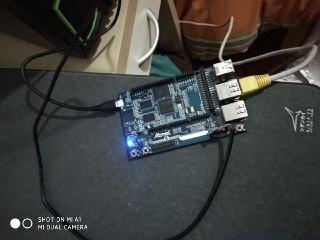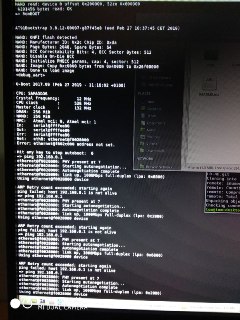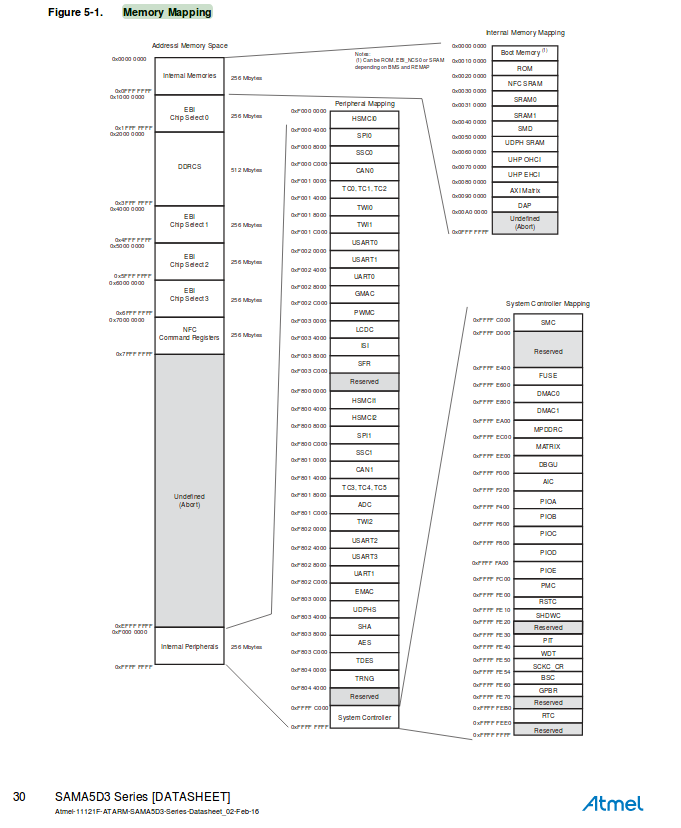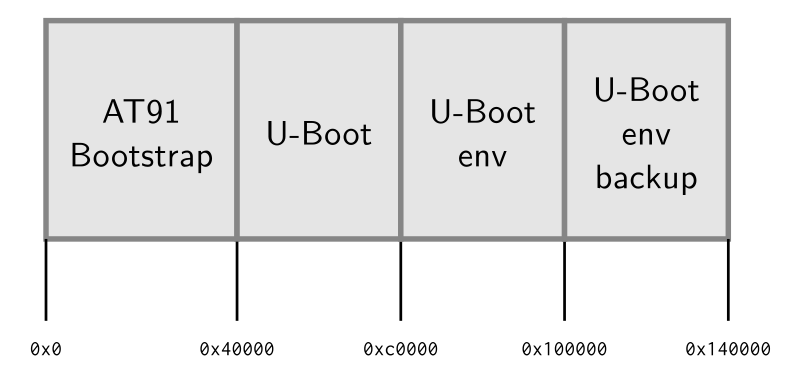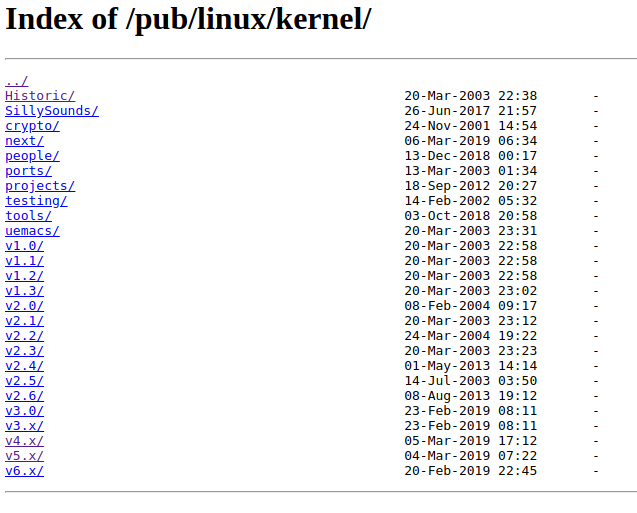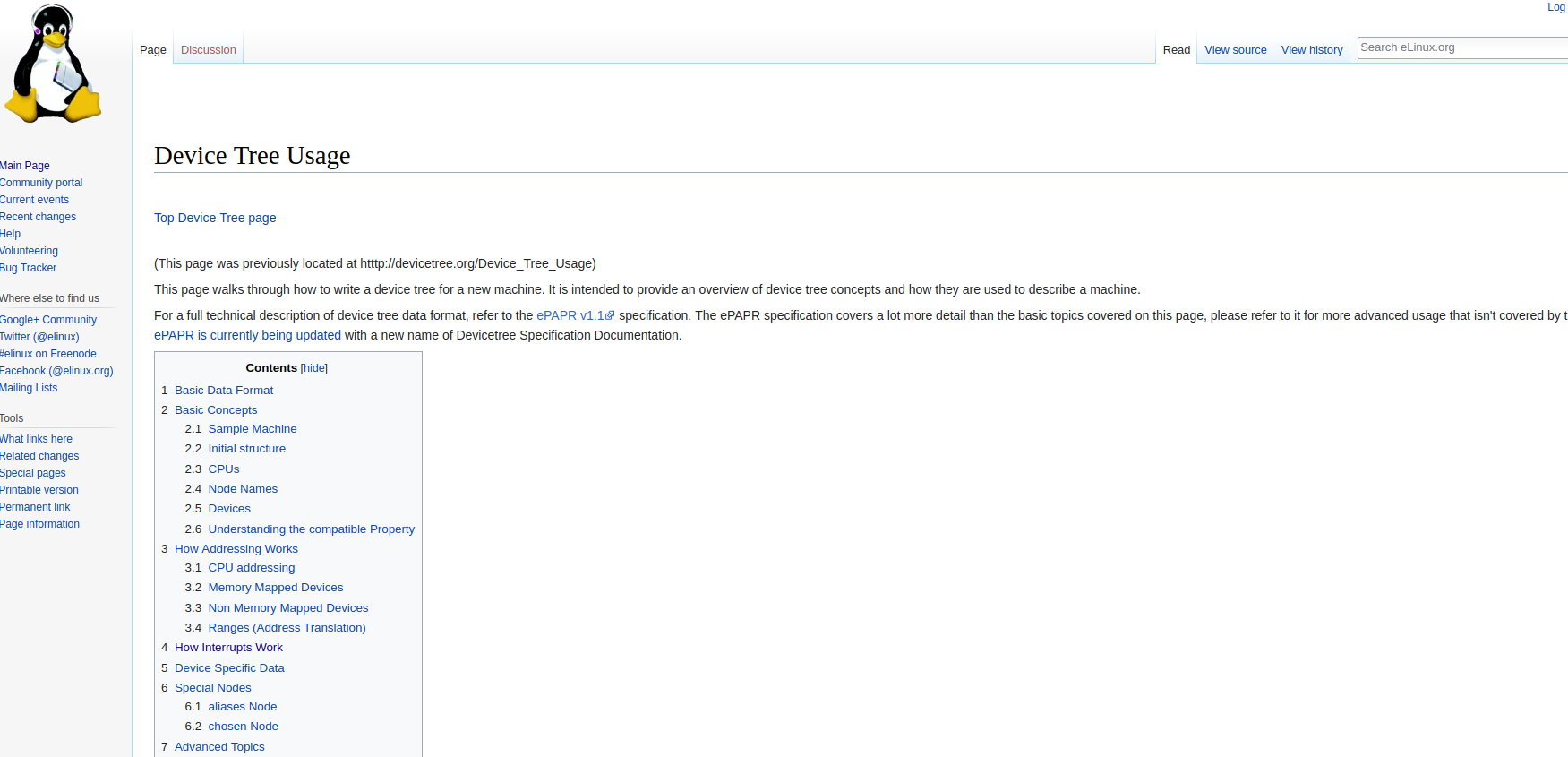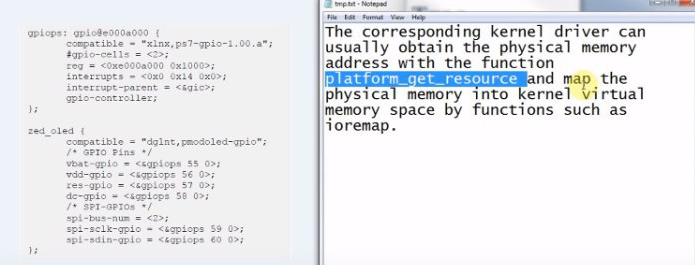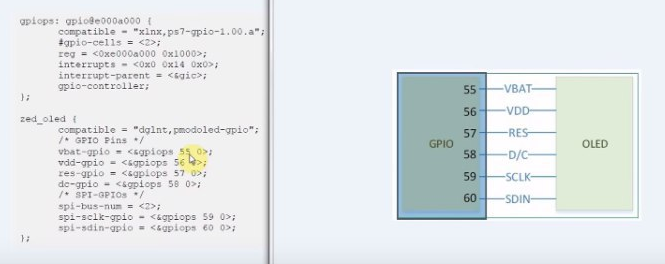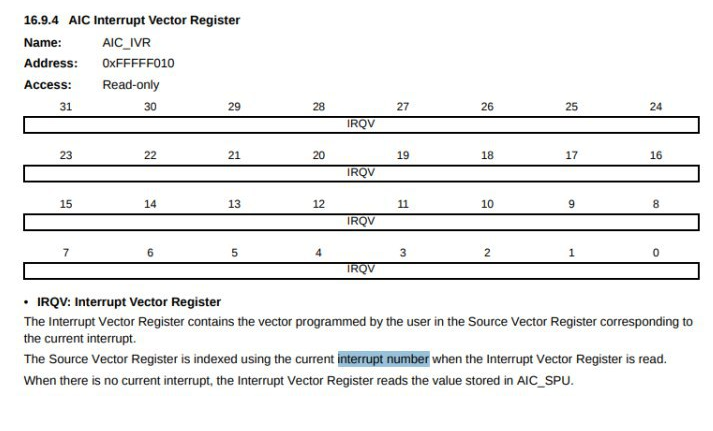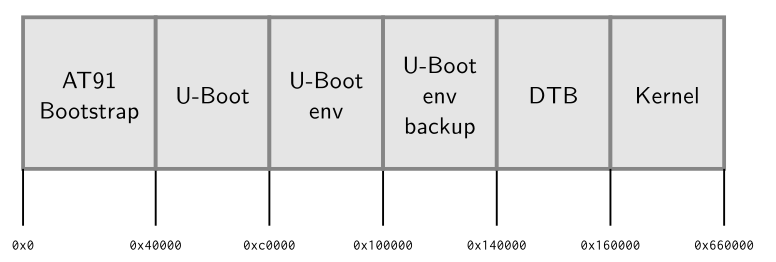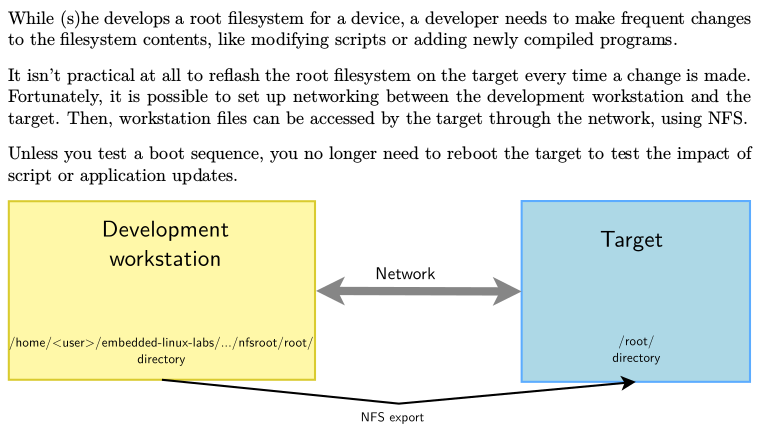Bring up Linux kernel 5.0 on ATSAMA5D3-XPLD-ND
##BRING UP LINUX
export PATH=~/x-tools/arm-cortexa5-linux-uclibcgnueabihf/bin:$PATH
export CROSS_COMPILE=arm-linux-
export ARCH=arm
##LS COMMAND export PATH=/usr/bin:/bin
https://bootlin.com/doc/training/linux-kernel/ wget https://bootlin.com/doc/training/embedded-linux/embedded-linux-labs.tar.xz
$ sudo apt install build-essential git autoconf bison flex texinfo help2man gawk libtool-bin libncurses5-dev
###CROSSTOOL-NG git clone https://github.com/crosstool-ng/crosstool-ng.git
$ ./bootstrap
$ ./configure --enable-local
$ make
$ ./ct-ng help [help]
$ ./ct-ng arm-cortexa5-linux-uclibcgnueabihf
$ ./ct-ng menuconfig
Path and misc options: --> Change Maximum log level to see to DEBUG Toolchain options: --> Set Tuple's alias to "arm-linux" C-library: --> Enable IPv6 support Debug facilities: --> Only enable strace support
$ export PATH=$HOME/x-tools/arm-cortexa5-linux-uclibcgnueabihf/bin/
###CLEAN
$ ./ct-ng clean
###TO COMPILE
$ arm-linux-gcc hello.c
###DOWNLOAD MICROCHIP FLASHING-TOOL [sam-ba]
$ wget http://ww1.microchip.com/downloads/en/DeviceDoc/sam-ba_2.15.zip
Install picocom:
$ sudo apt install picocom
$ sudo adduser $USER dialout
$ picocom -b 115200 /dev/ttyUSB0
AT91BOOTSTRAP SETUP BOOTSTRAP IN SRAM THAT INITIALIZE DRAM WITH U-BOOT INSIDE THAT LOAD THE LINUX KERNEL
$ git clone https://github.com/linux4sam/at91bootstrap.git
$ cd at91bootstrap
$ git checkout v3.8.9
$ ./ct-ng build (BUILT IN $HOME/x-tools/)
$ make sama5d3_xplainednf_uboot_defconfig
#SET ENVIRONMENT VARIABLE $ export CROSS_COMPILE=arm-linux
remove the NAND CS jumper on the board
press the RESET button
Put the jumper back
running samba64
$ ./sam-ba_64 in his folder
Select the ttyACM0 connection, and the at91sama5d3x-xplained board. Hit Connect.
Hit the NANDFlash tab
In the Scripts choices, select:
Enable NandFlash and hit Execute
Select Erase All, and execute the command
Then, select and execute:
Enable OS PMECC parameters
In order to change the NAND ECC parameters to what RomBOOT expects.
Finally, send the image we just compiled using the command:
Send Boot File
keep sam-ba open!!!!
download u-boot-->wget ftp://ftp.denx.de/pub/u-boot/u-boot-2017.09.tar.bz2
$ make <NAME>_defconfig NAME = sama5d3_xplained_nandflash
$ sudo apt install device-tree-compiler
make that build u-boot
Look at the size of the u-boot.bin:
$ ls -l <FILE-NAME> --> too large
$ make menuconfig
Look for and disable the below options
ext4 options
• nfs options
• USB options
• SPL options
• XIMG support
• FIT (Flattened Image Tree) support
• CMD_ELF option
• dhcp command support
• Regular expression support (REGEX)
• loadb support
• CMD_MII option
recompile --> $ make
In sam-ba, in the Send File Name field, set the path to the u-boot.bin that was just compiled, and set the address to 0x40000. Click on the Send File button.
###TESTING U-BOOT AND AT91Bootstrap
Reset the board and check that it boots your new bootloaders
--->help to see u-boot commands
$ sudo apt-get install tftp
https://www.poftut.com/install-configure-run-linux-tftp-client/ http://wiki.r1soft.com/display/ServerBackupManager/Configure+a+TFTP+server+on+Linux https://www.linuxquestions.org/questions/linux-embedded-and-single-board-computer-78/tftp-retry-count-exceeds-4175430611/
->folder-> /var/lib/tftpboot/ -> Create file.txt
$ sudo apt-get install xinetd
->folder ->create /etc/xinetd.d/tftp
To set up create tftp file and write:
service tftp { protocol = udp port = 69 socket_type = dgram wait = yes user = nobody server = /usr/sbin/in.tftpd server_args = -s /var/lib/tftpboot [FOR CHANGE THE DEFAULT TFTP FOLDER] disable = no }
$ ifconfig -a
->enp0s31f6 Link encap:Ethernet HWaddr 70:85:c2:57:82:ae
UP BROADCAST MULTICAST MTU:1500 Metric:1
RX packets:0 errors:0 dropped:0 overruns:0 frame:0
TX packets:49 errors:0 dropped:0 overruns:0 carrier:0
collisions:0 txqueuelen:1000
RX bytes:0 (0.0 B) TX bytes:6175 (6.1 KB)
Interrupt:16 Memory:df100000-df120000
Configuring the host(My PC) IP address from command line (ip address = 192.168.0.1).
$ nmcli con add type ethernet ifname enp0s31f6 ip4 192.168.0.1/24
Configure the network on the board in U-Boot by setting the ipaddr and serverip envi-ronment variables:
setenv ipaddr 192.168.0.100 (Target IP)
setenv serverip 192.168.0.1 (My PC/Host IP)
set the MAC address in U-boot:
setenv ethaddr 12:34:56:ab:cd:ef (Target Mac address)
saveenv
reset
To check if all working try to ping the Host(Server) from uBoot:
ping 192.168.0.1
and try to write prova.txt with something inside using :
tftp 0x22000000 textfile.txt
The tftp command should have downloaded the textfile.txt file from your development workstation into the board’s memory at location 0x22000000.
Verify with:
md 0x22000000
############################ ETHERNET ISSUES ###########################
Setting up tftp server (https://docs.khadas.com/vim1/SetupTFTPServer.html)
$ sudo apt-get install openbsd-inetd tftpd tft
$ apt-get install inetutils-inetd
$ sudo apt-get update -y
$ sudo apt-get install -y xinetd
To enable the TFTP server, edit the file /etc/inetd.conf as the root user, and locate the line that looks like the following:
#tftp dgram udp wait root /usr/sbin/tcpd /usr/sbin/in.tftpd Uncomment this line, and add the option and value -s /srv/tftp to the end of this line:
tftp dgram udp wait root /usr/sbin/tcpd /usr/sbin/in.tftpd -s /srv/tftp
Create and modify permissions on the TFTP root directory:
$ sudo mkdir /srv/tftp
$ sudo chown -R $(whoami) /srv/tftp
Restart the TFTP Service:
$ sudo /etc/init.d/xinetd restart
Download your kernel version https://mirrors.edge.kernel.org/pub/linux/kernel/
Go to the $HOME/embedded-linux-labs/kernel directory:
######################CORE-KERNEL-CHANGES##########################################################
arch/arm/mm/flush.c | 1 +
1 file changed, 1 insertion(+)
diff --git a/arch/arm/mm/flush.c b/arch/arm/mm/flush.c
index 58469623b015..5345f86c56d2 100644
--- a/arch/arm/mm/flush.c
+++ b/arch/arm/mm/flush.c
@@ -295,6 +295,7 @@ void __sync_icache_dcache(pte_t pteval)
if (pte_exec(pteval))
__flush_icache_all();
}
+EXPORT_SYMBOL_GPL(__sync_icache_dcache);
#endif
#################INSTRUCTIONS################################################################
$ export PATH="~/x-tools/arm-cortexa5-linux-uclibcgnueabihf/bin/":$PATH
$ export CROSS_COMPILE="arm-linux-"
$ export ARCH="arm"
$ make menuconfig
$ make -j[core numbers]
After build you can find the Kernel image (zImage) in:
arch/arm/boot/
linaro_guide_pdf -> ./device_tree_guide.pdf
tutorial -> http://junyelee.blogspot.com/2015/07/a-tutorial-on-device-tree.html?m=1
language -> https://elinux.org/Device_Tree_Usage
To compile .dts for our board ( at91-sama5d3_xplained.dts ) in his relative blob at91-sama5d3_xplained.dtb:
$ make ARCH=arm CROSS_COMPILE=arm-linux- sama5_defconfig [ Search in ---> arch/arm/configs your board ]
$ make
$ make ARCH=arm CROSS_COMPILE=arm-linux- dtbs
Compiled .dtb is in arch/arm/boot/dts folder
###############################################################################################
HOW CREATE FIRST .dtb
Hi all, After compiling your kernel, check this directory: /arch/arm/boot/dts copy these three files:
skeleton.dtsi
socfpga.dtsi
socfpga_cyclone5.dts
Now from the Embedded Command Shell, compile these files into a single .dtb file:
* dtc -I dts -O dtb -o socfpga.dtb socfpga_cyclone5.dts
Copy the generated socfpga.dtb to your SD card and you should be able to boot kernel.
I tried this with kernel version 3.10-ltsi, and I think all kernel versions come with .dts files.
Note that you should edit .dts files according to the implemented hardware design. Usually, sopc2dts tool should do that but I have been struggling for a few days with this tool without getting any bootable .dtb file. Probably XML board files I am using are corrupted or incompatible with new kernels, and I could not find working copies for my board DE1-SoC.
##2----> https://forum.rocketboards.org/t/build-own-device-tree-and-linux-kernel/177/13
Read the Linaro guide in this Folder (4_6048767180722406692.pdf) or the following tutorial:
---> http://xillybus.com/tutorials/device-tree-zynq-1
---> https://www.youtube.com/watch?v=zkCbO4XhKx4&t=308s
There are two ways to boot the kernel using U-Boot, After we chose the type of booting procedure you need to automate it writing u-boot script that do that.
- Using tftp connection, booting from tftp. From U-Boot:
Commands:
tftp 0x21000000 zImage
tftp 0x22000000 at91-sama5d3_xplained.dtb
bootz 0x21000000 - 0x22000000
Scripts in U-boot "bootcmd" variable:
setenv bootcmd 'tftp 0x21000000 zImage; tftp 0x22000000 at91-sama5d3_xplained.dtb; bootz 0x21000000 - 0x22000000'
saveenv
press the board reset button to check
- Booting Kernel image and .dtb from Nand flash.
From tftp server to RAM address:
tftp 0x21000000 zImage
tftp 0x22000000 at91-sama5d3_xplained.dtb
Erase the NAND flash memory:
nand erase 0x140000 0x20000
nand erase 0x160000 0x500000
Write from RAM address to NAND flash memory address:
nand write 0x22000000 0x140000 0x20000
nand write 0x21000000 0x160000 0x500000
Read from NAND memory using RAM memory and booting the kernel:
nand read 0x22000000 0x140000 0x20000
nand read 0x21000000 0x160000 0x500000
bootz 0x21000000 - 0x22000000
Scripts in U-boot "bootcmd" variable:
setenv bootcmd 'nand read 0x22000000 0x140000 0x20000; nand read 0x21000000 0x160000 0x500000; bootz 0x21000000 - 0x22000000'
saveenv
press the board reset button to check
Save first script in another variable:
setenv bootcmdtftp ${bootcmd}
You see Linux boot and finally panicking. This is expected: we haven’t provided aworking root filesystem for our device yet.
Go to the $HOME/embedded-linux-labs/tinysystem/ directory.
$ sudo apt install nfs-kernel-server
$ sudo gedit /etc/exports
Add the following line suppose IP address of our board will be 192.168.0.100:
/home/<user>/embedded-linux-labs/tinysystem/nfsroot 192.168.0.100(rw,no_root_squash,no_subtree_check)
Then:
$ sudo service nfs-kernel-server restart
From U-boot shell add this variabler in one-line:
setenv bootargs console=ttyS0,115200 root=/dev/nfs ip=192.168.0.100:::::eth0 nfsroot=192.168.0.1:/home/<user>/embedded-linux-labs/tinysystem/nfsroot,nfsvers=3 rw
saveenv
First in nfsroot folder create dev folder:
$ cd nfsroot
$ mkdir dev
Download the sources of latest of Busybox:
Install required packages:
$ sudo apt install libglade2-dev
configure BusyBox with the configuration file provided in the data, or modify .config file that appear after we use:
$ make menuconfig
Specify the installation directory for Busy-Box in this case:
$ ../nfsroot
We can change using again:
$ make menuconfig
In Install Options -> BusyBox installation prefix. Then:
$ make install
Create in the target /sys, /proc, /etc directory, then reboot.
Create a /etc/inittab file and a /etc/init.d/rcS startup script declared in /etc/ inittab. In this startup script, mount the /proc and /sys filesystems. In the BusyBox sources, read details about /etc/inittab in the examples/inittab file.
In /etc/inittab change:
::askfirst:/bin/sh
with:
ttyS0::askfirst:/bin/sh
On /etc/iniot.d/rcS mount the /proc and /sys filesystems:
#!/bin/busybox sh
mount -t proc p /proc
mount -t proc p /sys


